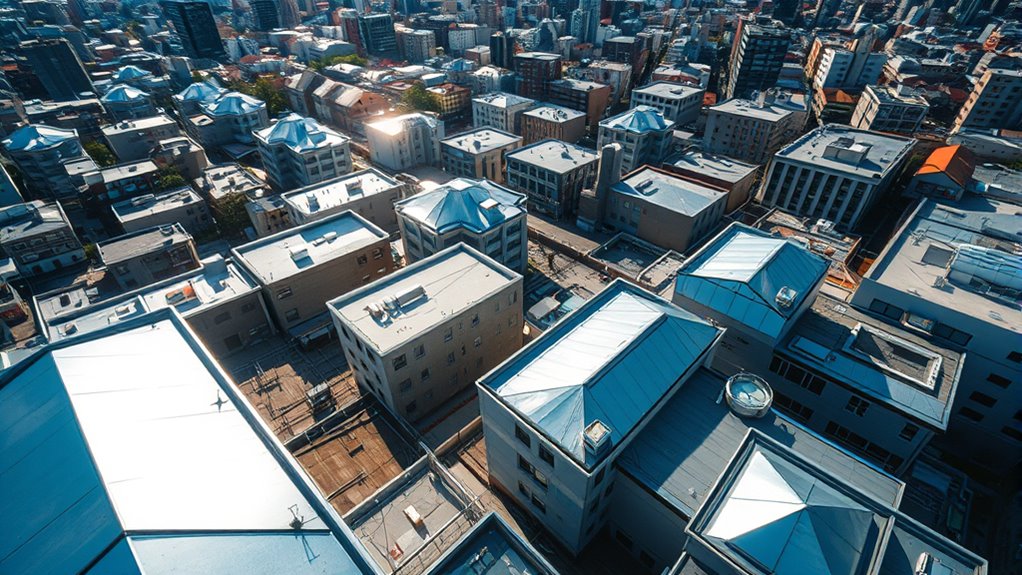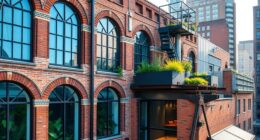Cool roofs and reflective surfaces help you reduce urban heat, making cities more comfortable and energy-efficient. By bouncing sunlight away and releasing less heat, these features lower your building’s temperature and cut down on air conditioning costs. They also protect roofing materials from damage and extend their lifespan. This sustainable approach not only saves money but also contributes to a healthier environment. Keep exploring to discover how these innovations can benefit your community and your wallet.
Key Takeaways
- Cool roofs and reflective surfaces reduce urban heat island effects by minimizing heat absorption and promoting heat emission.
- These surfaces lower indoor temperatures and enhance occupant comfort without excessive air conditioning use.
- Implementing reflective materials decreases energy consumption and utility costs for cooling.
- They extend roof lifespan by reducing material degradation caused by high temperatures.
- Reflective surfaces contribute to environmentally friendly urban development by decreasing greenhouse gas emissions.

Cool roofs and reflective surfaces are innovative solutions that help reduce urban heat and lower energy costs. When you install a cool roof, you’re actively combating the urban heat island effect, which causes cities to be considerably warmer than surrounding rural areas. This phenomenon occurs because concrete, asphalt, and other building materials absorb and retain heat during the day, releasing it slowly at night. By choosing reflective surfaces, you prevent much of that heat absorption, keeping your building cooler and reducing the temperature of the surrounding environment. This not only makes your space more comfortable but also has a profound impact on the city’s overall climate. When urban heat is minimized, you’ll notice a decrease in the demand for air conditioning, leading directly to energy savings. These savings are especially crucial during peak summer months when energy consumption spikes, helping you cut costs on utility bills.
Choosing cool roofs with high reflectivity and emissivity ensures that your building reflects more sunlight and emits less heat. This means your cooling systems don’t have to work as hard, reducing energy consumption. As a result, you benefit from lower energy bills and contribute to reducing greenhouse gas emissions. Cooler roofs also extend the lifespan of your roofing materials because they’re less exposed to the damaging effects of high temperatures that cause materials to degrade faster. This durability translates into fewer repairs and replacements, further boosting your savings over time. Additionally, by decreasing the heat absorbed by your building, you’re creating a more comfortable indoor environment without relying heavily on air conditioning, which can be especially beneficial in densely populated urban areas where heat management is critical. Implementing reflective surfaces also supports energy efficiency and sustainable building practices that are increasingly encouraged by urban policies.
Making this switch not only benefits your property but also contributes to a healthier environment and more sustainable cities.
Frequently Asked Questions
How Do Reflective Surfaces Impact Local Wildlife and Ecosystems?
Reflective surfaces can disrupt local wildlife and ecosystems by altering natural light and temperature patterns. You might notice wildlife changing behaviors or habitats as they adapt to these new conditions. This disruption can upset the ecosystem balance, affecting species that rely on specific environmental cues. By understanding these impacts, you can help minimize wildlife disturbance and preserve ecosystem health when implementing reflective surfaces in your community.
Are Reflective Roofs Suitable for All Climate Zones Worldwide?
Reflective roofs aren’t suitable for all climate zones because they can increase urban heat in colder regions, reducing energy efficiency by making heating needed more intense. In warmer areas, they help combat urban heat and lower cooling costs. You should consider your local climate when choosing a reflective roof, as it impacts energy efficiency and urban heat mitigation differently depending on the region’s temperature and weather patterns.
What Are the Long-Term Maintenance Requirements for Cool Roofs?
Think of your cool roof as a trusted friend that needs care to stay shining. You’ll need to follow simple maintenance routines like regular cleaning and inspections to remove debris and prevent damage. Durability considerations mean occasionally checking for wear and tear, especially after storms. By staying proactive, you keep your roof’s reflective properties effective and extend its lifespan, ensuring it continues to keep your home cooler and your energy bills lower.
Can Reflective Surfaces Be Integrated With Solar Panel Installations?
Yes, you can integrate reflective surfaces with solar panel installations. To guarantee ideal solar panel efficiency, choose surface materials compatible with the panels, like certain reflective coatings or materials that don’t cause overheating. Proper installation and spacing are essential to prevent shading and maintain airflow, which helps keep panels cool and functioning efficiently. Regular maintenance of both the reflective surface and panels will maximize their lifespan and energy output.
How Do Reflective Surfaces Affect Heating and Cooling Costs in Winter?
Reflective surfaces in winter can reduce heating costs by improving thermal insulation, keeping heat inside your building. They reflect heat away from the roof, which might seem counterintuitive, but in colder months, their insulating properties help maintain warmer indoor temperatures. This boosts your overall energy efficiency, saving you money on heating. However, if not properly designed, they could also slightly increase cooling costs during warmer months.
Conclusion
By choosing cool roofs and reflective surfaces, you reduce heat, lower energy costs, and improve comfort. You reflect sunlight, resist heat absorption, and promote sustainability. You protect the environment, save resources, and create healthier living spaces. By making these choices, you embrace a cooler, greener future—one roof at a time. You take action, make a difference, and build a more sustainable world for everyone.










